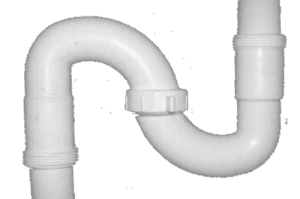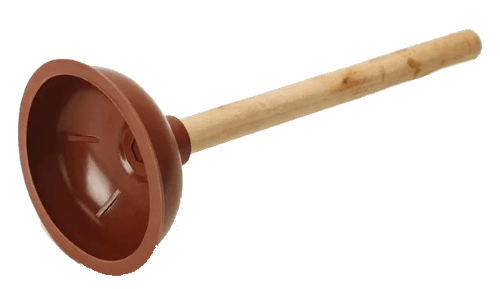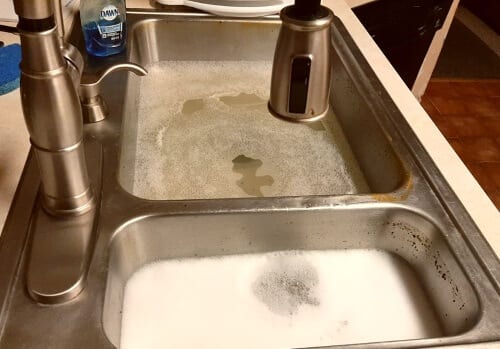The Basics Of Unclogging A Drain
It may be time to add some
“elbow grease”

Jerry’s Plumbing & Heating
8 July 2019
You’ll Eventually have to Unclog a Drain
You change the oil in your car regularly. You visit the dentist twice a year. You even go to gym a couple times a week. All to avoid unexpected problems. But if you having indoor plumbing – and we all do – you eventually have to deal with unclogging a drain.
However, a clogged drain doesn’t have to be a huge downer. No need to have your day ruined. There are just a few basics you need to know, a few things to avoid, and a couple “how-to” steps to follow to keep your all your drains flowing.
In this article, we’ll explain some drain basics – the types of drains in your home and some ways to keep them clean and clog-free. In future articles (
Read More: The Best Way To Unclog A Drain
), we’ll discuss some of the best ways to unclog a drain and why you should avoid certain “other” ways (Read More: Avoid These Ways To Unclog A Drain
) to unclog a drain.The Drain Cleaning “Trap”
Before you start to tackle a clogged drain, it might to explain, in simple terms, the basic drain system of a typical home. That will guide you to what clogs you can handle on your own, what clogs may require some help, and what clogs should definitely be handled by a professional plumber.
The first thing water – and anything else that gets past the drain – encounters after leaving a sink or tub is something called a “trap.” A trap is the curved piece of pipe, usually shaped like a “P,” directly downstream of the drain. The reason you need a trap is to prevent sewer gases from coming up from the sewer and into your home.

When water flows out of your sink or tub, some of it remains in the lower part of the bend in the trap. That little bit of water keeps sewer gases out.
Older homes used to have (and many still do) an “S” trap. These traps works in essentially the same way as ‘P” traps. But “P” traps have vents where they turn downward toward the sewer stack. “S” traps aren’t properly vented. 

Many states have now outlawed “S” traps by code. Check with a licensed plumber to see if you should have your old “S” traps replaced with newer “P” traps.
““P” traps have vents where they turn downward toward the sewer stack. “S” traps aren’t properly vented.”
3 Tips for Unclogging A Drain
Most clogs usually happen in or near the trap. In the kitchen sink, they consist of grease or fat or bits of food. They’re usually made up of hair in bathroom sinks or tubs.
Soften things a bit
Sometimes, all these clogs need is a bit of softening up to get them cleaned out. Hot or even boiling water is the easiest, quickest and cheapest way to clear a clog so try that first.
A note of caution: Only use boiling water if you have metal pipes. Avoid using boiling water if you have plastic or PVC pipes. Water that’s hotter than 175 F can damage some types of PVC pipe. And be careful when pouring the boiling water directly into a porcelain sink. The hot water on a cool basin can crack it.
Some people have had some luck unclogging a drain by using salt and boiling water, vinegar and baking soda, baking soda and salt or even just some dishwashing liquid. These “home remedies” work by softening the clog. With a bit of patience – you may have to wait overnight in some cases – the clogs may loosen themselves.
However, these drain cleaning methods often lead to a sink of tub full of nasty water over a stubborn clog. It may be time to add some “elbow grease.”


A little help please?
At the first sign of a clog, most people grab the “plumber’s helper”- a plunger. Just be sure to use the right kind of plunger and use it correctly. We explain all about plungers in the next article (
Read More: The Best Way To Unclog A Drain
).A clean sweep
Finally, you can clean your drain’s P-trap to clear the clog. Just place a bucket under the drain to catch any water or debris that may fall out. Unfasten the P-trap from the drainpipe and clear out anything that is stuck in there. Then merely replace the trap and run water through it.


Things are Stacking Up
We’ll explain in more detail how to unclog your drain in our next article in this series,
Read More: The Best Way To Unclog A Drain
.Beyond all the various traps in your plumbing system is the sewer stack. This is a bigger pipe system that collects all the waste water and sends it out of your house.
Many sewer stacks – but not all – have a check valve just before they exit your house. This prevents any raw sewage from backing-up into your home. Again, check with a licensed plumber to see if you have a sewer check valve and have one installed if you don’t.
If your clog is beyond the trap and into the sewer stack, you may need to use some type of auger to break-up or remove the clog. Augers aren’t very expensive and seem, at first glance, easy to use. But you should be very careful not to scratch you sink, tub or toilet if you decide to go this route.
Also, unclogging a drain at this level tends to be a larger job and requires significantly more effort and skill to acheive. If you’re not sure how to use an auger properly, you may end up with a clog AND and auger stuck in you pipes.
Once the sewer pipe leaves your home, waste water enters the sewage system of your town or your septic system. Clogs at this point are generally caused by root penetration. Tree roots can be quite powerful as they seek water wherever it’s available, including your sewer pipe. Problem clogs here are best left to professional plumbers.


Avoid the clog
Maybe the best drain cleaning advice might be avoiding a clog in the first place. Pouring equal parts of vinegar and baking soda down the drain on a regular basis will keep your sink smelling fresh and running clean. It goes without saying that you should never put bacon grease, coffee grounds or oils down your kitchen drain.
But when a clog does happen – and it eventually will – start by softening the clog and see if that clears it. You may have to use a plunger or even clean the trap manually. We discuss some things you should definitely NOT do in our final article in this series,
Read More: Avoid These Ways To Unclog A Drain
.For deeper, more stubborn clogs, however, it may be easier and cheaper in the long run to call your local licensed plumber. They’ll know exactly what to do to get your water flowing again in no time.



0 Comments